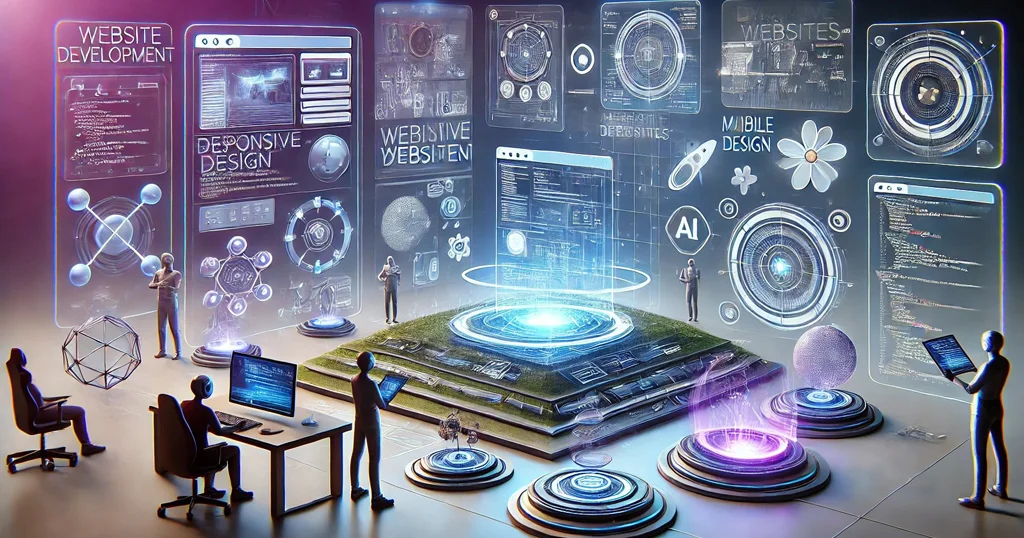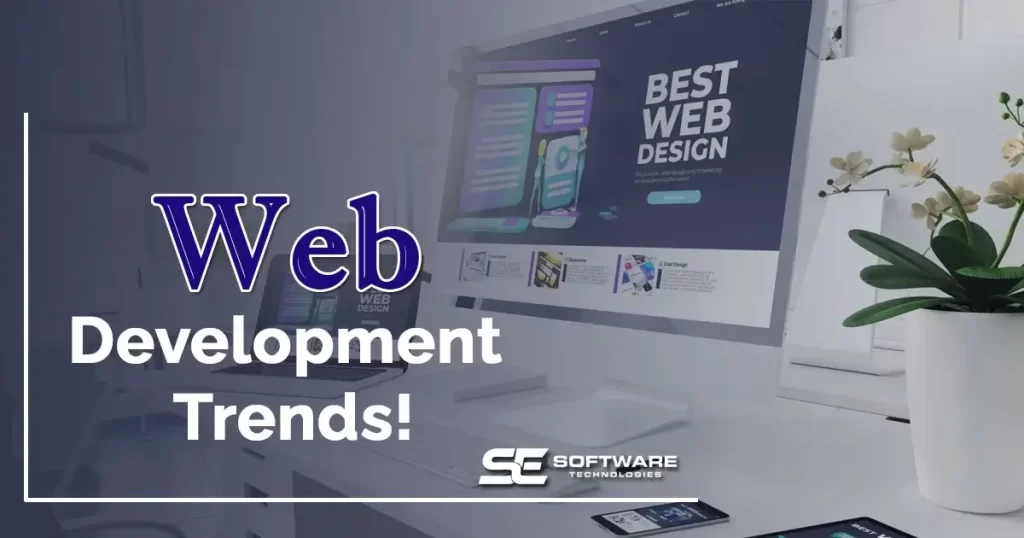As we head into 2025, the world of website development continues to evolve at a rapid pace, driven by advancements in technology, user demands, and the increasing importance of delivering dynamic, immersive, and user-friendly digital experiences. Developers today are challenged to build faster, smarter, and more accessible websites while keeping pace with trends that prioritize personalization, ustainability, and new modes of interaction. In this blog, we will explore key trends that are poised to shape the future of website development in 2025 and beyond, including AI integration, Web3 technologies, sustainable web practices, and more.
1. Artificial Intelligence and Machine Learning in Web Development
AI and machine learning are increasingly integral to modern web development, enabling developers to automate repetitive tasks, enhance UX, and provide more personalized web experiences. AI-driven tools are expected to become even more sophisticated in 2025, offering capabilities that streamline the web development process, from coding to content creation and beyond.
Key Applications of AI in Web Development
- Code Generation and Bug Fixing: Tools like GitHub Copilot and Tabnine already use AI to assist developers with code completion and error detection. By 2025, these tools are likely to evolve further, allowing developers to create robust codebases with minimal manual coding.
- Content Personalization: AI algorithms can analyze user behavior and preferences,
enabling websites to deliver personalized content and product recommendations. In e-commerce, for instance, personalized AI-driven experiences can boost conversion rates and enhance customer satisfaction. - Chatbots and Virtual Assistants: Chatbots powered by natural language processing
(NLP) are set to become more advanced, offering 24/7 support with improved contextual understanding, making customer support faster and more efficient.
AI integration not only reduces the workload for developers but also elevates the user experience, creating websites that are interactive, responsive, and tailored to individual user needs.
2. Green Web Development: Building Sustainable Websites
Sustainability is no longer an afterthought. As environmental concerns grow, more businesses are adopting green web development ractices to minimize their digital carbon footprint. A sustainable website not only reduces energy consumption but also promotes a brand’s commitment to eco-friendly practices, an appealing factor for the eco-conscious consumer.
Techniques for Sustainable Web Development
- Efficient Coding Practices: Lightweight code and optimized images can reduce server load and improve page load speeds, which, in turn, conserves energy.
- Green Hosting Solutions: Hosting providers that utilize renewable energy sources, such as Google Cloud’s carbon-neutral hosting, are becoming more popular. By 2025,more businesses are likely to switch to green hosting services to enhance sustainability.
- Designing for Minimalism: A minimalist approach, which reduces the number of images, animations, and unnecessary scripts, not only enhances user experience but also saves energy by minimizing server requests.
Green web development is not only better for the planet, but it can also improve website performance, resulting in faster load times and a better overall user experience.
3. Enhanced Web Accessibility and Inclusive Design
In 2025, accessibility will be a non-negotiable aspect of website development. Inclusive design ensures that all users, regardless of their physical or cognitive abilities, can interact with a website effectively. Accessibility is not only an ethical and legal responsibility but also a
practical necessity, as it broadens the website’s reach and user base.
Key Components of Web Accessibility
- Keyboard Navigation: Many users rely on keyboards rather than mice for navigation. Websites must support keyboard shortcuts and focus indicators to help users navigate with ease.
- Voice Search and Interaction: With the increasing use of voice-activated devices, websites should optimize for voice search compatibility. Ensuring accurate voic recognition and clear audio descriptions for content makes a website more accessible to
those with visual impairments. - AI-powered Accessibility Tools: AI can be used to automatically detect accessibility issues in real time, ensuring that websites comply with Web Content Accessibility Guidelines (WCAG) standards.
Prioritizing accessibility not only opens doors for more users but also enhances SEO, as search engines are increasingly rewarding accessible sites with better visibility.
4. Progressive Web Apps (PWAs)
Progressive Web Apps (PWAs) have been around for a while, but by 2025, they are expected to become a standard in web development due to their reliability, speed, and engaging user experience. PWAs combine the best features of both websites and native mobile apps, allowing users to access them offline and enjoy app-like experiences.
Benefits of PWAs
- Offline Access: PWAs store content locally, which means users can still access the app’s core functionality and content even without an internet connection.
- Fast Load Times: PWAs are built for speed, loading almost instantly, regardless of the device or network conditions.
- Cross-platform Compatibility: PWAs work on all devices with a single codebase, making them a cost-effective solution for businesses aiming to reach both desktop and mobile users.
With the potential to deliver native app functionality and offline capabilities, PWAs are likely to dominate the mobile web landscape in the coming years.
5. Voice User Interface (VUI) and Voice Search Optimization
Voice search is on the rise, and by 2025, voice user interfaces (VUIs) will become an essential part of website development. With the growing popularity of smart speakers and voice-activated assistants, websites will need to be optimized for voice search and cater to voice-
activated commands.
Tips for Voice Search Optimization
- Conversational Keywords: Voice searches tend to be more conversational, so incorporating natural language and question-based phrases into website content can improve discoverability.
- Local SEO for Voice Search: Many voice searches are location-based (e.g., “restaurants near me”), making it crucial for businesses to optimize for local search terms.
- Schema Markup: Adding structured data can help search engines understand and display information accurately in voice search results, making the website more accessible to voice-enabled devices.
As VUIs continue to improve, voice optimization will become a necessary feature for creating seamless user experiences and staying competitive.
6. Low-Code and No-Code Development Platforms
The demand for web development continues to outpace the availability of skilled developers. In response, low-code and no-code platforms are becoming popular, allowing non-technical users to build functional websites with minimal or no coding experience. By 2025, these platforms are expected to become even more sophisticated and widely adopted.
Advantages of Low-Code/No-Code Platforms
- Faster Development Cycles: These platforms speed up the development process, enabling businesses to launch websites or applications quickly.
- Cost-Effective: With less dependency on coding expertise, low-code/no-code platforms can reduce development costs significantly.
- Empowerment of Non-technical Users: By democratizing website creation, businesses can empower employees across departments to contribute to web projects, fostering innovation and collaboration.
While traditional coding skills remain valuable, low-code and no-code platforms are transforming the landscape, making web development accessible to a broader audience.
7. 3D Elements and Immersive Web Design
With advancements in WebGL and other browser-based 3D rendering technologies, immersive web experiences using 3D elements, animations, and virtual reality are set to become mainstream by 2025. These elements can engage users on a deeper level, making websites more interactive and visually captivating.
How to Implement 3D Design on Websites
- Use Lightweight 3D Elements: To avoid slowing down page load times, lightweight 3D graphics and animations are essential. Optimized 3D models can still deliver impact without affecting performance.
- Augmented Reality (AR) and Virtual Reality (VR): Implementing AR and VR features, especially in e-commerce and real estate, allows users to interact with products in a virtual space.
- Scroll-triggered Animations: Engaging users with animations triggered by scrolling can create a storytelling effect that enhances user engagement.
3D design is particularly valuable for brands aiming to create memorable experiences, and as technology improves, we can expect more immersive elements across various industries.
8. Web3 Technologies and Decentralized Applications (dApps)
Web3 is changing the way we interact with the internet by introducing decentralized applications (dApps) that operate on blockchain technology. By 2025, Web3 may influence website development significantly, from user data ownership to new forms of content distribution and monetization.
Key Aspects of Web3 in Web Development
- Decentralization: Unlike traditional websites that rely on centralized servers, Web3 sites can leverage blockchain for secure, decentralized data storage.
- Smart Contracts: Automated smart contracts allow for secure and transparent transactions, potentially revolutionizing e-commerce and user interaction on the web.
- User Privacy and Data Ownership: With Web3, users can have greater control over their personal data, which could foster more trust between users and brands.
As Web3 adoption grows, developers will need to familiarize themselves with blockchain technology and decentralized architectures to stay relevant.
9. Cybersecurity and Data Privacy
With an increasing number of users prioritizing data privacy, cybersecurity will remain a top priority in 2025. Websites that offer robust security measures and transparent data policies will gain a competitive edge, as users are more likely to trust sites that prioritize their privacy.
Essential Security Measures for 2025
- Multi-Factor Authentication (MFA): MFA adds an extra layer of security, ensuring that only authorized users can access sensitive areas of the site.
- Data Encryption: Encrypting data in transit and at rest helps protect user information from unauthorized access.
- Regular Security Audits: Conducting regular security audits can help identify vulnerabilities before they are exploited.





